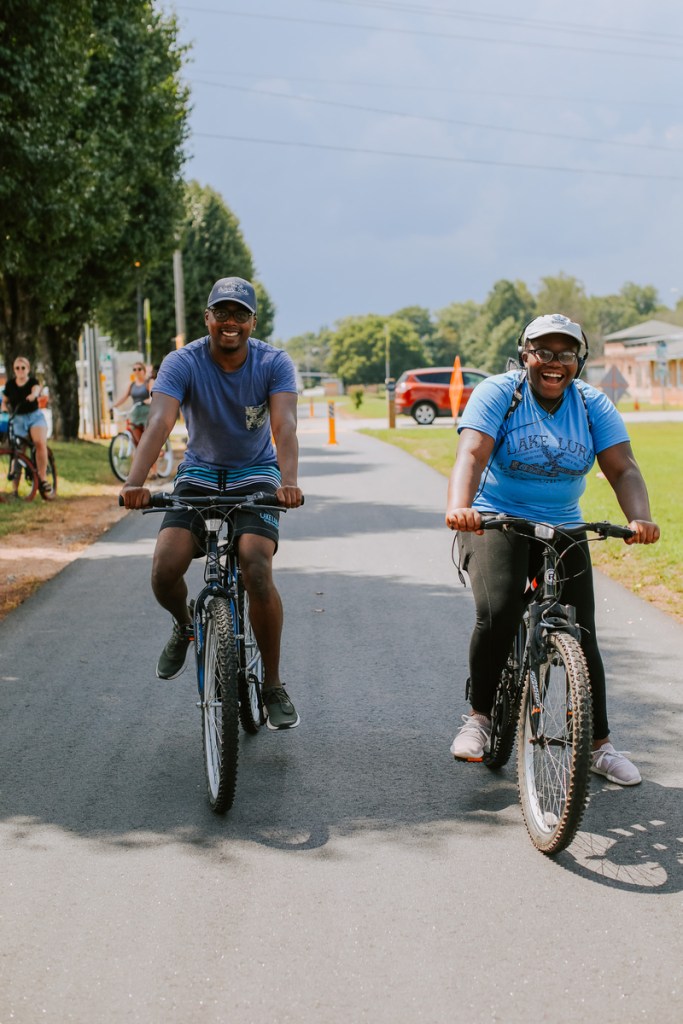Rail trails provide a path to healthier communities
Published 9:32 am Monday, May 27, 2024

- Cyclists enjoy the Thermal Belt Rail Trail in neighboring Rutherford County.
|
Getting your Trinity Audio player ready...
|
By Carolyn Baughman
One day, while at work, Illinois native Shawn Gossman reached down to tie his shoes. It was a simple task he didn’t think much about until he sat up and became dizzy and out of breath. This was a lightning bolt moment for Sean, who was overweight, a heavy smoker, and only in his twenties.
Sean realized, “I was experiencing my own health crisis.”
A friend suggested riding a bike for exercise. Sean purchased one and headed straight for his local Tunnel Hill State rail trail in southwest Illinois. On his first rail trail ride, Gossman recalls, “I fell instantly in love with the trail and cycling.” When Sean was on the trail, he found that he loved being in nature and connecting with other people.
It wasn’t long before Sean quit smoking, started eating healthier, and even met the love of his life. Together, they now share a love of hiking and cycling on their local rail trail.
Sean’s wellness journey is not unlike many Americans who have poor health, followed by a lightbulb moment. His earlier health conditions mirror the profile of many. Data from the Polk County Health Data Report reveals that heart disease causes the highest number of deaths in our community. It also accounts for 21.4% of deaths nationally, according to US News and World Report. Conditions such as high cholesterol, high blood pressure, insulin resistance, and diabetes are also contributing factors to poor health in Americans, both locally and nationally.
However, the U.S. Centers for Disease Control and Prevention cites a 2022 study that for inactive people (about 25% of our national population), simply increasing physical activity is the best way to improve overall health.
In Sean Gossman’s case, that was through his rail trail. According to Rails to Trails Conservancy, rail trails can “help people of all ages incorporate exercise into their daily routines by connecting them with places they want or need to go.” They add, “Communities that encourage physical activity by making use of linear corridors can see a significant effect on public health and wellness.”
For more information, I turned to local Functional Medicine Physician Dr. Lisa Broyles. Dr. Broyles and her family have lived in Saluda for eight years.
“I’m excited about the Saluda Grade Trail coming,” she says about the proposed rail trail. “Maybe this could be a place where people could walk, bike, and skate.”
Dr. Broyles lives a healthy lifestyle, mixing in different activities with her family, like hiking, biking, yoga, and horseback riding. She noted, “I like to change things up. I think it’s important as you age not to do one type of exercise. This helps avoid wearing out joints.” When asked about the health benefits a rail trail could provide, Dr. Broyles shared, “Exercise burns calories and lowers blood sugar. Skeletal muscle uses glucose for energy, and when people get on the trail and walk, bike, or jog, they are lowering their blood glucose.”
Dr. Broyles added the rail trail could also provide mental health benefits for the community, noting that being outside in nature can create an “endorphine release [which] impacts mood, depression, and anxiety.” Furthermore, she adds, “When you’re out in nature, you’re inhaling the clean air and hearing the birds sing instead of the rumble of traffic. This helps you feel more grounded and gain some introspection.”
Next, I asked Dr. Broyles how a rail trail might impact families and the broader community. She shared, “You have different options for enjoying the trail: you can walk the trail with friends and family, you can also walk side by side and engage in different forms of exercise.” She added, “For people with physical limitations, this may be the only way they can get out in nature.”
Specifically in her hometown, Dr. Broyles noted, “I think one of the limitations to healthy living for Saluda is that the terrain is very hilly, and people with physical limitations have a hard time safely exercising. The trail would provide a safer, graded trail where people could exercise.”
“I’m really excited about the Saluda grade Trail coming. I think some people are concerned this is going to change Polk County. We also love that it’s rural, and not a lot of people know about us. But change is going to happen, so I feel like we should encourage change in a healthier direction.”
The proposed Saluda Grade Trail would create a 31-mile mixed-use corridor along the historic Saluda Grade Railway, connecting communities from Inman, SC, to Zirconia, NC.
For more information about the Saluda Grade Trail, visit saludagradetrail.org.





